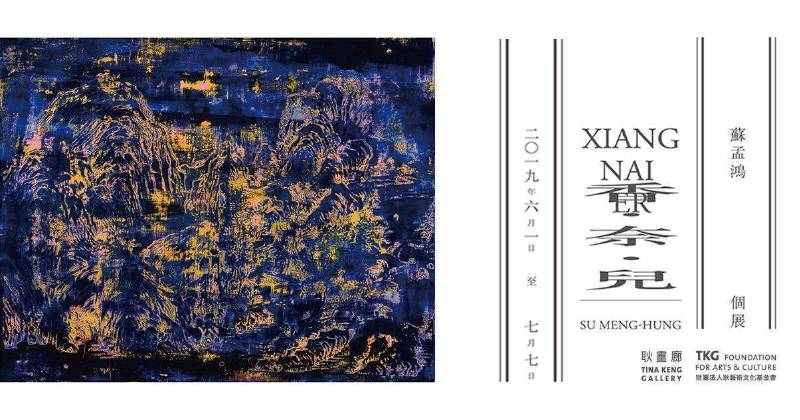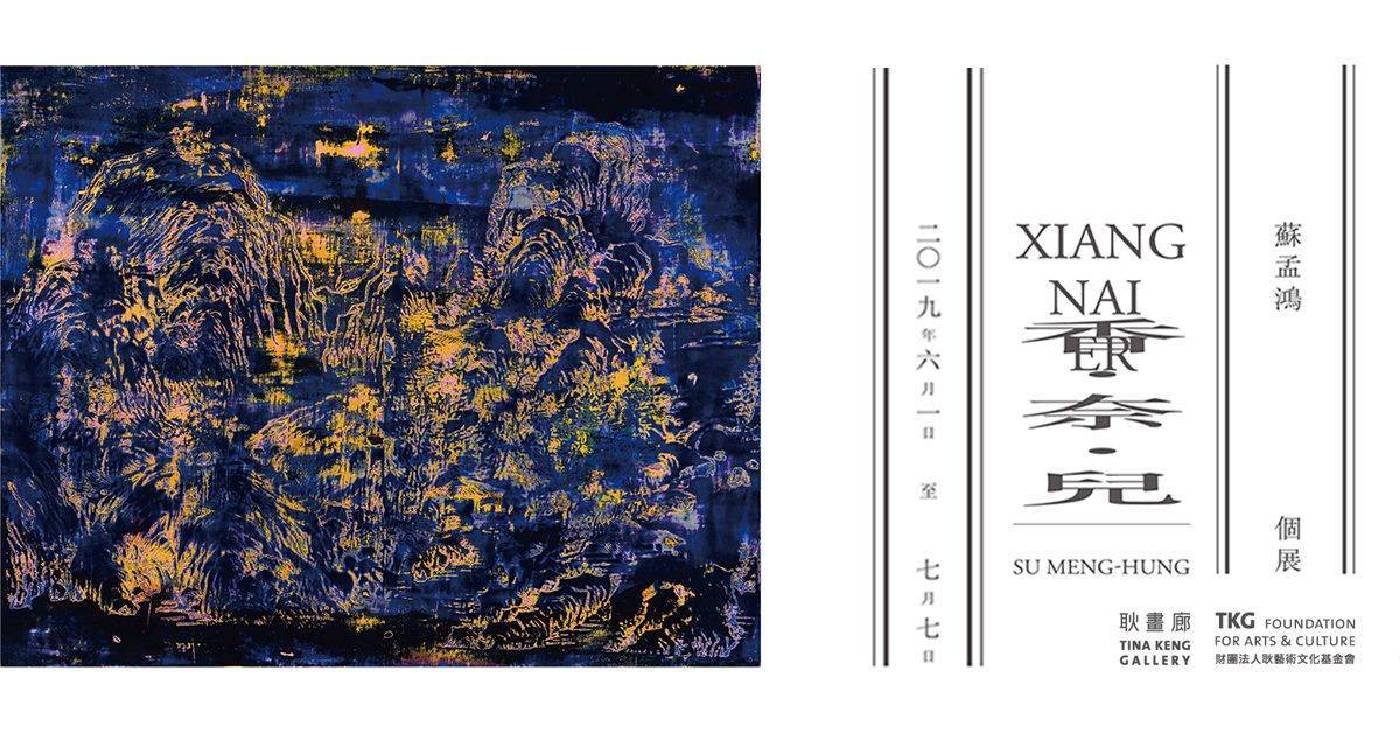耿畫廊
【香·奈·兒Xiang Nai Er 】蘇孟鴻個展

-
展期
日期:2019-06-01 ~ 2019-07-07
-
地點
114 台北市內湖區瑞光路548巷15號1樓
-
參展藝術家
蘇孟鴻
-
展期│ 2019/06/01 - 2019/07/07
開幕│ 2019/06/01 (六) 4:30 p.m.
地點│ 耿畫廊 台北市內湖區瑞光路548巷15號1樓
『這系列創作非關香奈兒,但也關於香奈兒。』
拼貼成中國花鳥形制的珠貝飾片,鑲嵌於古雅漆面烏木,同象牙、玉石、琺瑯,與金銀所組構的金碧山水,譜出華美而細緻的東方氛圍—這是令香奈兒(Coco Chanel)女士終生著迷不已的烏木雕漆屏風。令人驚艷的中式傳統工藝所散發的神秘東洋風情,成為香奈兒女士廣為人知的靈感繆思—自此,一面面烏木屏風上演示的花鳥、山水圖像成為模組化了的東方文化符碼,躍上高級訂製服的襯裡印花、珠寶首飾等臻品設計,於各種形象元素的演繹中,裹著 Chanel 優雅經典的品牌風格,躍入高端時尚的國際視野。
然而,中國雕製的烏木屏風,在西方世界卻有個非關中國的別稱「Coromandel Screen」,遙指東印度科羅曼德海岸這於十七世紀末中國傢俱貨物裝載運往歐洲的殖民地商港。時至今日,字面仍隱隱溢散著一股馬可波羅式的泛東方情懷,彷彿隔著絲綢紗羅凝望時代之外的模糊異國輪廓,並由烏木屏風上一式式山水花鳥繪畫模組呈現的美學意象,將源自西方核心的想像重新拼貼,組構出已然獨立於中國文化之外的泛化東方風情。
這觸發了蘇孟鴻 2018-2019 年新作—「香奈兒」系列繪畫的概念源起。對他而言,任何事物經轉譯後所留下的美麗符徵(signifier),或因某種浪漫誤會而成就出的一個個荒謬符旨(signified),反而更加貼近當代藝術的現實指涉。一如「香奈兒」之名,經不同媒體與創作者們傳播轉化,烙印於大眾腦海中的種種風格影像,讓「香・奈・兒」已不僅只屬於香奈兒(Chanel),而是轉生為一組乘載並重構一切相關文化意象的有機字彙。對此,蘇孟鴻在「香奈兒」系列繪畫的回應中,以香奈兒女士收藏的烏木雕漆屏風為視覺藍本,結合抽象表現主義以及潑墨山水式的自動性技法,將一層層厚質顏料堆疊,後以砂紙打磨令線稿顯影,徒留斑剝線條色團為其美感來源。穿插其間的樣板圖像,取自匯集名家畫稿,堪稱國畫啟蒙經典的《芥子園畫譜》及、中國文學巨著《紅樓夢》及近代四大奇書之一《金瓶梅》內頁圖像插畫。去敘事化的繪畫呈現,令觀者於作品前立時散失觀看焦點—而在虛無與華麗、唯美與媚俗、文人風雅與當代消費等視覺語彙的並置共讀間,開展出更寬廣的指涉可能。
建築師暨作家阮慶岳評述:「蘇孟鴻作品裡的感官與物質性格,有著曖昧留白的不語姿態。在花鳥山水與春宮畫稿被抽離並碎片化的拼貼間,斷離原本歷史與文本的記憶關連,佈置成另外一幅去知識的華麗視覺景象,以俗豔般的符號姿態面對人間,飄染著些許對抗與嘲弄的氣息⋯⋯透過象徵/比喻並用的藝術手法,藉此回視透過雙重辯證下的可能新意。」夾雜著關於招貼以及展示等之於繪畫的功能與意義,「香奈兒」繪畫系列體現著蘇孟鴻一貫著眼於已然樣板化、模組化以及獵奇化的圖像偏好;在西方抽象表現以及張大千表演式的潑墨山水技法交匯中,已然雜交出一種以多義性、歧異性堆疊繪畫藝術史觀念與風格主義的地質學景觀。「香・奈・兒」系列繪畫,非關卻也殘有「香奈兒」於文化維度留下的餘溫—正如藝術,又是屬於誰的藝術?從傳統卻非經典的圖像出發,樣板化、模組化的藝術印記成為一種具「創造性維度」的象徵/比喻,以及其所表達「意在言外」的指涉意涵,向當代社會現象直接回應,同時對古典作出精神呼喚與救贖期待。
------
Exhibition Dates | 06.01.2019 – 07.07.2019
Opening | 06.01.2019 (Sat.) 4:30 p.m.
Venue | Tina Keng Gallery (1F, No. 15, Ln. 548, Ruiguang Rd., Neihu Dist., Taipei, Taiwan 114)
“This series of works is, and isn’t about Chanel/Xiang Nai Er (Chanel in Chinese transliteration).”
A mosaic collage of pearl shells in the shape of Chinese flowers and birds inlaid in antique lacquered ebony, against a resplendent landscape of ivory, jade, enamel, gold, and silver, enshrouds the viewer in a magnificent and delicate Eastern atmosphere — the ebony lacquer screen that enchanted Ms. Coco Chanel all her life. Fascinated by the mysterious aura of this Chinese traditional craft, Ms. Chanel turned it into her renowned source of inspiration. Ever since then, the still life and landscape depicted on the ebony screens have been transformed into prevalent Eastern cultural symbols. Embroidered onto exquisite fabric in haute couture, reincarnated as luxury jewelry design, these symbols redefined by Chanel’s elegant and classical style, garner international attention.
Chinese ebony screens have a non-Chinese nickname in the Western world: “coromandel screen,” referring to the Coromandel Coast of southeastern India, a colonial trading port from which Chinese furniture goods were once shipped to Europe in the late 17th century. Even today, this nickname still faintly exudes the ambience of the Marco Polo era, conjuring an exotic silhouette obscured by time. The imagery on the ebony screen — vivid flowers and birds against idyllic landscapes — transmutes the Western notions of China into a pan-Eastern sentiment that is now independent of Chinese culture.
This has inspired Su Meng-Hung’s latest painting series “Xiang Nai Er” (2018–2019). For Su, if anything after being translated could leave behind either a stunning signifier, or an absurd signified because of a romantic misunderstanding, this would come awfully close to what art is in reality. Just like the brand Chanel evokes distinct imagery after being conveyed through different media outlets and appropriated by different artists, the name “Xiang Nai Er” no longer belongs to Chanel. Instead, the name metamorphoses into an organic term that reconfigures Chanel’s every cultural connotation. In response, Su sees Ms. Chanel’s collection of ebony lacquer screens as his muse, fusing abstract expressionism with automatism manifested in splashed ink landscape. He renders the imagery effaced and buried beneath layers of thick paint, and the surface would be sanded to allow the image to re-emerge, yet leaving lines or clusters of paint that have survived the attrition as the visual aesthetics of the painting.
The interspersed images are adopted from eminent Chinese classical painting technique book Manual of the Mustard Seed Garden, Chinese literary masterpiece Dream of the Red Chamber, and the erotic illustrations from Chinese literary classic The Golden Lotus. Accordingly, Su’s work exhibits a dualistic sensory and material character. The artist deliberately juxtaposes diametric opposites — nothingness and splendor, secularity and religion, integrity and fragmentation, Eastern tradition and Western classics — to challenge fixed dichotomies, reading them together to discover new knowledge and expand the possibilities of wider reference.
“In crafting the sensory and material character of his work, Su develops an ambiguous visual style, often eluding the true implications of his referents — as seen in the still life paintings, flower and bird paintings, and the erotic paintings referenced by him — by detaching and fragmenting them,” architect and writer Roan Ching-Yueh comments on Su’s work thus. “By re-contextualizing these symbols, he dissociates them from their original historical and cultural significances. The artist arranges them into a naive, flamboyant scene, facing society with vulgar symbolic gestures and a sense of confrontation and ridicule.”
“Xiang Nai Er” is a series of paintings that embeds the function and meaning of poster and display in painting. The series comprises the artist’s years-long affinity for visual motifs that have been stylized and modeled into uniform, grotesque imagery, as well as an incorporation of Western expressionism and Zhang Daquian-esque performative techniques of splashed ink landscape. Chanel no longer belongs to Chanel. Just like to whom art belongs? Despite that the “Xiang Nai Er” series is not about Chanel, it is steeped in the profound implications that the brand has etched into the contemporary psyche. Su Meng-Hung begins with traditional but non-classical imagery, using stylized, uniform motifs as visual reference with a new creative dimension. His latest solo exhibition is simultaneously a direct response to contemporary social phenomena, and a spiritual calling with redemption expectations for the classical.

